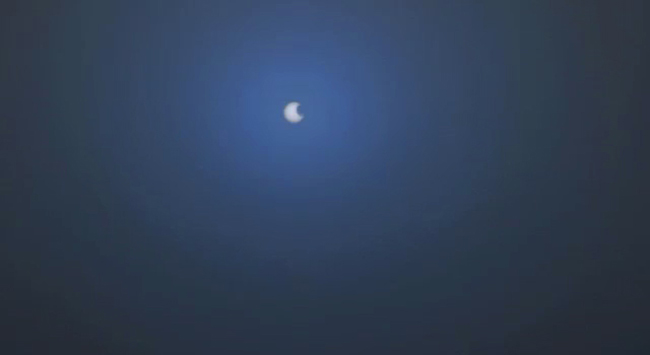New Mars Movies Give Rover's-Eye View of Red Planet

Two new NASA movie clips transport regular Earthbound folks to the Martian surface, giving them a rover's-eye view of a bluish Martian sunset and a partial solar eclipse.
Researchers created the videos using pictures taken by NASA's Mars rover Opportunity, which has been chugging around the Red Planet's surface since January 2004. One movie shows the sun setting over the Martian horizon, while the other shows the Mars moon Phobos traversing the face of the sun.
"These visualizations of an alien sunset show what it must have looked like for Opportunity, in a way we rarely get to see, with motion," rover science team member Mark Lemmon of Texas A&M University said in a statement.
The sunset movie combines exposures taken by Opportunity's panoramic camera (Pancam) on Nov. 4 and Nov. 5, 2010, and also inserts some simulated frames to smooth the action, researchers said. It accelerates about 17 minutes of sunset into a 30-second clip. [New Martian sunset movie]
In the video, dust particles make the Martian sky appear reddish and create a bluish glow around the sun.
The rover team has taken Pancam images of sunsets on several previous occasions, gaining scientifically valuable information about the variability of dust in Mars' lower atmosphere. The new clip is the longest sunset movie from Mars ever produced, taking advantage of high levels of solar energy currently available to Opportunity, researchers said.
Watching a partial solar eclipse on Mars
Breaking space news, the latest updates on rocket launches, skywatching events and more!
The second video shows a partial eclipse of the sun by the Mars moon Phobos. (Both Phobos and Deimos, Mars' other satellite, are too small to fully cover the sun's face when they transit — or pass in front of — the sun, as seen from the Martian surface.)
To make the eclipse movie, researchers chose a transit by Phobos shortly before the Martian sunset on Nov. 9, 2010. They chose a series of Pancam exposures taken four seconds apart, combining them and some simulated frames to build the new 30-second video. [New Martian solar eclipse movie]
The video has more than mere gee-whiz appeal, researchers said. Images that show Phobos' exact position relative to the sun at an exact moment in time help scientists study slight changes in the moon's orbit. This, in turn, adds to what scientists know about the interior of Mars.
The world has learned a lot from movies like the two new clips, and from the quarter-million or so other images that Opportunity and its twin rover, Spirit, have taken since they landed on Mars in January 2004, researchers said.
"For nearly seven years now, we've been using the cameras on Spirit and Opportunity to help us experience Mars as if we were there, viewing these spectacular vistas for ourselves," said Pancam lead scientist Jim Bell of Cornell University, who put the two new movies together with Lemmon. "Whether it's seeing glorious sunsets and eclipses like these, or the many different and lovely sandy and rocky landscapes that we've driven through over the years, we are all truly exploring Mars through the lenses of our hardy robotic emissaries."

Space.com is the premier source of space exploration, innovation and astronomy news, chronicling (and celebrating) humanity's ongoing expansion across the final frontier. Originally founded in 1999, Space.com is, and always has been, the passion of writers and editors who are space fans and also trained journalists. Our current news team consists of Editor-in-Chief Tariq Malik; Editor Hanneke Weitering, Senior Space Writer Mike Wall; Senior Writer Meghan Bartels; Senior Writer Chelsea Gohd, Senior Writer Tereza Pultarova and Staff Writer Alexander Cox, focusing on e-commerce. Senior Producer Steve Spaleta oversees our space videos, with Diana Whitcroft as our Social Media Editor.
